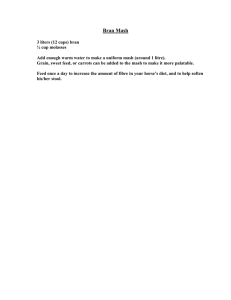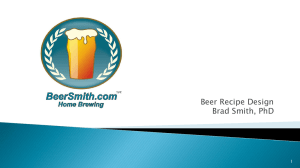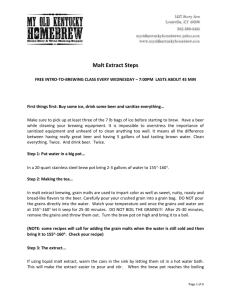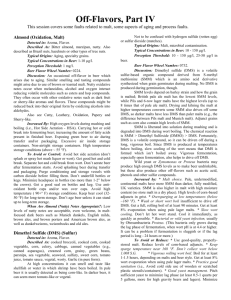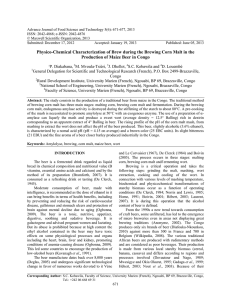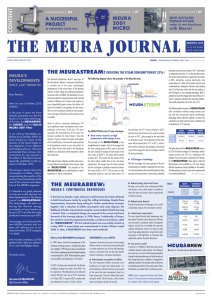Brewing William Harrison`s Beer: Lessons learned in redacting and
advertisement
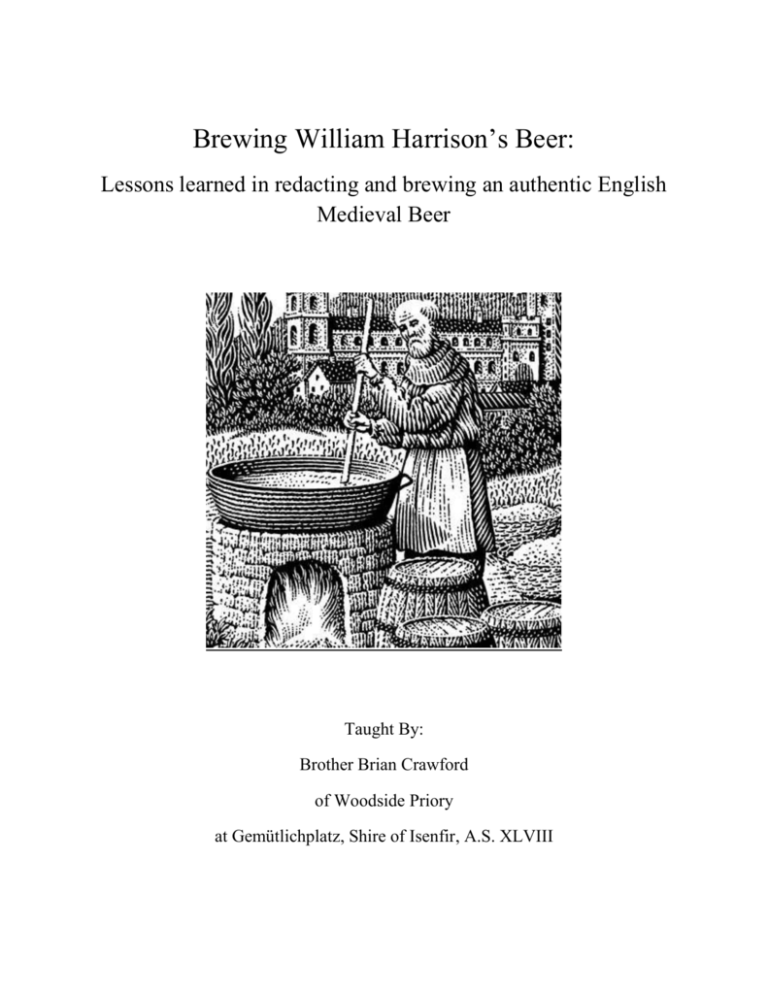
Brewing William Harrison’s Beer:
Lessons learned in redacting and brewing an authentic English
Medieval Beer
Taught By:
Brother Brian Crawford
of Woodside Priory
at Gemütlichplatz, Shire of Isenfir, A.S. XLVIII
Original Recipe:
“Nevertheless, sith I have taken occasion to speak of brewing, I will exemplify in such a proportion as I
am best skilled in, because it is the usual rate for mine own family, and once a month practiced by my
wife and her maid servants, who proceed withal after this manner as she hath oft informed me.
{1} Having therefore ground eight bushels of good malt upon our querne, where the toll is saved,1 she
addeth unto it half a bushel of wheat meal, and so much of oats small ground, and so tempereth or
mixeth them with the malt, that you cannot easily discern the one from the other, otherwise these later
would clunter [clot], fall into lumps, and thereby become unprofitable. The first liquor which is a full
eighty gallons according to the proportion of our furnace, she maketh boiling hot, and then poureth it
softly into the malt, where it resteth (but without stirring) until her second liquor be ready to boil. This
done she letteth her mash run till the malt be left without liquor, or at the leastwise the greater part of
the moisture, which she percieveth by the stay and soft issue thereof, and by this time her second liquor
in the furnace is ready to seethe, which is put also to the malt as the first wort also again into the
furnace, whereunto she addeth two pounds of the best English hops, and so letteth them seethe
together by the space of two hours in summer, or an hour and a half in winter, whereby it getteth an
excellent color and continuance without impeachment, or any superfluous tartness. {2} But before she
putteth her first wort into the furnace, or mingleth it with the hops, she taketh out a vesselful, of eight
or nine gallons, which she shutteth up close, and suffereth no air to come into it till it become yellow,
and this she reseveth by itself unto further use, as shall appear hereafter, calling it Brackwoort or
Charwoort, and as she saith it addeth also to the color of the drink, whereby it yieldeth not unto amber
or fine gold in hew unto the eye. {1} By this time also her second wort is let run; and the first being taken
out of the furnace and placed to cool, she returneth the middle wort unto the furnace, where it is
striken [laded] over, or from whence it is taken again when it beginneth to boil and mashed the second
time, whilst the third liquor is heated (for there are three liquors), and this last put into the furnace
when the second is mashed again. When she hath mashed also the last liquor (and set the second to
cool by the first) she letteth it run and then seetheth it again with a pound and an half or of new hops or
peradventure two pounds as she seeth cause by the goodness or baseness of the hops; and when it hath
sodden [boiled] in summer two hours, and in winter an hour and a half, she striketh it also and reserveth
it unto mixture with the rest when time doth serve therefor. {2} Finally when she setteth her drink
together she addeth to her brackwoort or charwoort half an ounce of orris2 and half a quarter of an
ounce of bayberries3 finely powdered, and then putting the same into her wort with an handful of
wheat flour, she proceedeth in such usual order as common brewing requireth. Some instead of orris
and bays add so much long pepper only, but in her opinion and my liking it is not so good as the first, {1}
and hereof we make three hogsheads of good beer, such (I mean) as is meet for poor men as am I to live
withal whose small maintenance (for what great thing is forty pounds a year computis computandis
[taking everything into account] able to perform?) may endure no deeper cut, the charges whereof
groweth in this manner. I value my malt at ten shillings, my wood at foure shillings which I buy, my hops
at twenty pence, the spice at two pence, servants’ wages two shillings sixpence, with meat and drink,
and the wearing of my vessel at twenty pence, so that for my twenty shillings I have ten score gallons of
beer or more, notwithstanding the loss in seething. The continuance of the drink is always determined
after the quantity of the hops, so that being well hopped it lasteth longer. For it feedeth upon the hop
and holdeth out so long as the force of the same continueth which being extinguished the drink must be
spent or else it dieth and becometh of no value.” (Harrison 137-138).
My Final Recipe:
Ingredients:
17.75 pounds Marris-Otter malt
1 pound wheat meal
1 pound ground oats
2.5 ounces East Kent Golding hops
White Labs English Ale Yeast (WLP002)
5oz Priming Sugar
Water
Procedure:
1.
Heat 25 quarts of clean water to between 165 and 170 degrees Fahrenheit. Combine water
with grains in the mash tun, mix well. Target Mash temperature is between 150 and 155
degrees. Cover and allow to stand for 60 minutes.
2.
While mash is steeping, heat 39 quarts of clean water for sparging to between 170 and 180
degrees and place in the lauter tun until ready to use. Target sparge water temperature is
between 165 and 170 degrees.
3.
After mash has rested for 60 minutes, open the valve on the mash tun and, using two vessels
recirculate the wort until it runs clear. Once it runs clear allow wort to begin to drain into brew
kettle.
4.
When wort sits approximately one inch above the grain bed, begin to gently sparge the mash,
maintaining a 1 inch layer of liquid above the grain bed while the wort continues to drain into
the kettle. Continue to sparge until you have collected 7.5 to 8 gallons of wort.
5.
Bring the wort to a rolling boil and add all of the hops. Do not allow the wort to boil over. Boil
the wort for 90 minutes.
6.
Once the boil has been completed, cool the wort to pitching temperature of between 65 and 70
degrees (I use an immersion wort chiller to speed this process).
7.
Transfer to the sanitized primary fermenter and pitch the yeast. Stir vigorously to aerate.
8.
Seal fermenter with an airlock and allow to ferment at 65 to 70 degrees for one week.
9.
After the first week’s fermentation, siphon the beer off of the trub and gently transfer to a
sanitized glass carboy. Seal with an airlock and allow to ferment for an additional week.
10.
When fermentation is complete siphon the beer off of the trub into a sanitized bottling bucket.
11.
If you wish for carbonated beer, prepare the priming sugar by dissolving it in 2 cups hot water
and mix thoroughly into the beer before bottling.
12.
Bottle the beer in brown glass bottles with crown caps. If you will be bottle conditioning, allow
to stand at 65 to 70 degrees for an additional two weeks to carbonate.
13.
Chill and enjoy.
Lessons Learned:
Sources:
- Always attempt to seek out the primary source for the recipe and do a thorough read through
for supporting information.
- If there are multiple sources for the same recipe (i.e. primary vs secondary) differences
between them can be very telling.
- If the primary source lacks supporting details, seek out other sources for the time period and
locality in question.
- Modern brewing sources are helpful when period sources are ambiguous or give information
that doesn’t make sense.
Weights and Measures:
- This is the deepest rabbit hole that you can potentially fall down in interpreting your recipe.
- Measures varied widely over time, by locality, and by the goods being measured (e.g. Beer and
Ale brewers used different sized barrels).
-Just because it has a modern sounding name (gallons, pounds) doesn’t mean the measure is
even close to the modern version.
- If you can find a record defining what is meant by the various weights and measures this will
get you about 80% there, but you will still have to make educated guesses.
- The most important thing is to keep the ratio between ingredients consistent.
Ingredients:
Water:
- Harrison was well aware of water quality and recommended hard water for brewing.
- Ratio of water in recipe to amount of water in the batch size is best way to scale the other
ingredients.
-When scaling ingredients it is best to compare starting water to starting water volumes to keep
ratio of grain to water in the mash consistent.
Grains:
- Harrison describes malting in detail, and his description indicates a variety of malts available.
- Malt Harrison describes as preferable is a pale in color and lacks smoky flavors.
- All malts, regardless of type, would have been diastatic.
- Grain production has continued to advance since 1600, modern grains have nearly twice as
much starch as period ones so you will want to cut the amount of grain called for
roughly in half. (I failed to account for this in the recipe above)
Hops:
- Hops flavor vary by region so when in doubt pick a hop from same locality as the recipe.
- Traditional hop varieties have been bread to preserve their unique flavors, so you do not need
to halve the amount as with grain.
Yeast:
- Some recipes may call for “beer barm” but most make no mention yeast.
- I recommend choosing a commercial yeast that is appropriate to the style or region (in this
case English Ale Yeast).
Processes:
Mashing:
- Many recipes call for the mash water to be added at or near boiling, which is too hot at the
homebrew scale.
- I recommend going with a standardized mash temperature of 155 to 160 degrees to ensure an
effective conversion.
- Length of Mash may also be difficult to interpret, since mash times longer than 60 minutes
have greatly diminishing returns, 1 hour will likely meet your needs.
- Sparging is not a period technique. If the recipe calls for brewing multiple runnings separately,
simply brew the first running without sparging.
- For a “Full Gyle” beer such as Harrison’s (all runnings blended together) sparging creates a
similar effect to blending multiple runnings without taking nearly as much time.
Boiling:
- Boiling times may be ambiguous, or give you odd instructions (e.g. boiling two hours in
summer and 90 minutes in winter).
- 95% of alpha acid conversion takes place during the first 45 minutes and less than 1% after 90
minutes, so boils longer than 90 minutes are largely superfluous.
Fermentation:
- Some recipes will give elaborate descriptions of the “working” of the beer, but Harrison makes
no mention of it.
- Fermentation may have been in the storage containers or in open vessels.
-Since open fermentation risks infection and is messy, I recommend using a modern air lock.
Packaging:
- Harrison seems to suggest that his beer was served directly from the fermentation/storage
vessel after about a month of age.
- If this was a sealed cask, carbonation of the beer would have been likely.
- Recipes for open fermentation likely would have been flat.
- I choose to bottle condition my beer since I prefer carbonated beer.
Full documentation for this recipe, along with other documentation, and class handouts can be found at
my website: http://www.haakonstead.org/brian.html
Friends of Woodside Priory can follow us on Facebook at Woodside Priory - Haakon Brewery
